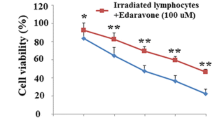Abstract
This study was conducted to evaluate the preventive effect of hesperetin against radiation-induced DNA damage and immune dysfunction in murine splenocytes. Isolated splenocytes from BALB/c mice were treated with hesperetin (20, 100, and 500 µM), and then irradiated at a dose of 2 and 4 Gy of γ-irradiation. Exposure to ?-radiation resulted in DNA damage and a reduction of cell viability as well as an elevation of the levels of proinflammatory cytokines, intracellular ROS (reactive oxygen species), and NO (nitric oxide). Hesperetin significantly enhanced the cell viability of the splenocytes compared with the irradiated group. In addition, hesperetin was found to be highly effective in preventing DNA damage as identified by comet and DNA ladder assays. Hesperetin also effectively inhibited proinflammatory cytokines, intracellular ROS, and NO in irradiated splenocytes. In conclusion, hesperetin was shown to be radioprotective against irradiation-induced DNA damage and immune dysfunction in murine splenocytes.
Similar content being viewed by others
References
Jagetia GC. Radioprotective potential of plants and herbs against the effects of ionizing radiation. J. Clin. Biochem. Nutr. 40: 74–81 (2007)
Hosoda M, Tokonami S, Sorimach A, Monzen S, Osanai M, Yamada M, Kashiwakura I, Akiba S. The time variation of dose rate artificially increased by the Fukushima nuclear crisis. Sci. Rep. 1: 87 (2011)
Hosoda M, Tokonami S, Tazoe H, Sorimachi A, Monzen S, Osanai M, Akata N, Kakiuchi H, Omori Y, Ishikawa T, Sahoo SK, Kovacs T, Yamada M, Nakata A, Yoshida M, Yoshino H, Mariya Y, Kashiwakura I. Activity concentrations of environmental samples collected in Fukushima Prefecture immediately after the Fukushima nuclear accident. Sci. Rep. 3: 2283 (2013)
Mates JM, Sanchez-Jimenez FM. Role of reactive oxygen species in apoptosis: Implications for cancer therapy. Int. J. Biochem. Cell Biol. 32: 157–170 (2000)
Lee W, Ahn G, Lee BJ, Wijesinghe WA, Kim D, Yang H, Kim YM, Park SJ, Jee Y, Jeon YJ. Radio-protective effect of polysaccharides isolated from Lactobacillus brevis-fermented Ecklonia cava. Int. J. Biol. Macromol. 52: 260–266 (2013)
Nair CKK, Parida DK, Nomura T. Radioprotectors in radiotherapy. J. Radiat. Res. 42: 21–37 (2001)
Hosseinimehr SJ. Trends in the development of radioprotective agents. Drug Discov. Today 12: 794–805 (2007)
Mansour HH, Hafez HF, Fahmy NM, Hanafi N. Protective effect of Nacetylcysteine against radiation induced DNA damage and hepatic toxicity in rats. Biochem. Pharmacol. 75: 773–780 (2008)
Garg A, Garg S, Zaneveld LJD, Singla AK. Chemistry and pharmacology of the citrus flavonoid hesperidin. Phytother. Res. 15: 655–669 (2001)
Kim JY, Jung KJ, Choi JS, Chong HY. Hesperetin: A potent antioxidant against peroxynitrite. Free Radic. Res. 38: 761–769 (2004)
Ameer B, Weintraub RA, Johnson JA, Yost RA, Rouseft RL. Flavanone absorption after naringin, hesperidin and citrus administration. Clin. Pharmacol. Ther. 60: 34–40 (1999)
Lee NK, Choi SH, Park SH, Park EK, Kim DH. Antiallergic activity of hesperidin is activated by intestinal microflora. Pharmacology 71: 174–180 (2004)
Pradeep K, Park SH, Ko KC. Hesperidin a flavanoglycone protects against gamma-irradiation induced hepatocellular damage and oxidative stress in Sprague-Dawley rats. Eur. J. Pharmacol. 587: 273–280 (2008)
Komarova EA, Christov K, Faerman AI, Gudkov AV. Different impact of p53 and p21 on the radiation response of mouse tissues. Oncogene 19: 3791–3798 (2000)
Bing SJ, Kim MJ, Park EJ, Ahn G, Kim DS, Ko RK, Lee NH, Shin TK, Park JW, Jee Y. 1,2,3,4,6-Penta-O-galloyl-β-D-glucose protects splenocytes against radiationinduced apoptosis in murine splenocytes. Biol. Pharm. Bull. 33: 1122–1127 (2010)
Jin YR, Han XH, Zhang YH, Lee JJ, Lim Y, Kim TJ, Yoo HS, Yun YP. Hespretin, a bioflavonoid, inhibits rat aortic vascular smooth muscle cells proliferation by arresting cell cycle. J. Cell. Biochem. 104: 1–14 (2008)
Rosenkranz AR, Schmaldienst S, Stuhlmeier KM, Chen W, Knapp W, Zlabinger GJ. A microplate assay for the detection of oxidative products using 2,7-dichlorefluorescein-diacetate. J. Immunol. Methods 156: 39–45 (1992)
Szumiel I. Ionizing radiation induced cell death. Int. J. Radiat. Biol. 66: 329–341 (1994)
Smina TP, De S, Devasagayam TPA, Adhikari S, Janardhanan KK. Ganoderma lucidum total triterpenes prevent radiation-induced DNA damage and apoptosis in splenic lymphocytes in vitro. Mutat. Res. Genet. Toxicol. Environ. Mutagen. 726: 188–194 (2011)
Ross GM. Induction of cell death by radiotherapy. Endocr. Relat. Cancer 6: 41–44 (1999)
Olive PL. Impact of the comet assay in radiobiology. Mutat. Res. 681: 13–23 (2009)
Trivedi PP, Tripathi DN, Jena GB. Hesperetin protects testicular toxicity of doxorubicin in rat: Role of NF-?B, p38 and caspase-3. Food Chem. Toxicol. 49: 838–847 (2011)
Zhou D, Yu T, Chen G, Brown SA, Yu Z, Mattson MP, Thompson JS. Effect of NF-kappaB1 (p50) targeted gene disruption on ionizing radiation-induced NF-kappaB activation and TNFalpha, IL-1alpha, IL-1beta and IL-6 mRNA expression in vivo. Int. J. Radiat. Biol. 77: 763–772 (2001)
Author information
Authors and Affiliations
Corresponding author
Rights and permissions
About this article
Cite this article
Kang, J.A., Yoon, S.H., Rho, J.K. et al. Radioprotective effect of hesperetin against γ-irradiation-induced DNA damage and immune dysfunction in murine splenocytes. Food Sci Biotechnol 25 (Suppl 1), 163–168 (2016). https://doi.org/10.1007/s10068-016-0114-7
Received:
Revised:
Accepted:
Published:
Issue Date:
DOI: https://doi.org/10.1007/s10068-016-0114-7




